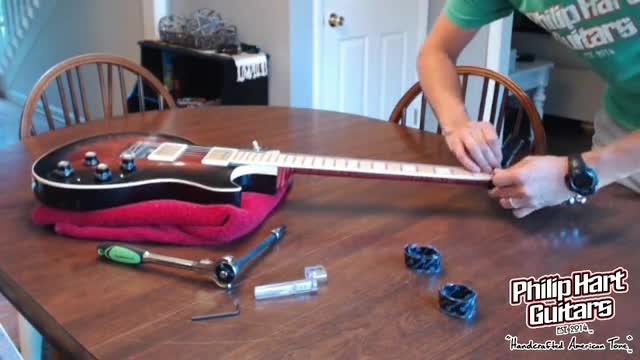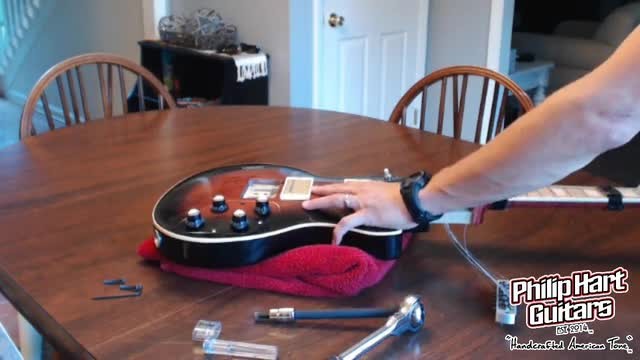

Our Story
My name is Philip Hart and in 2014 I started my own custom guitar company called Philip Hart Guitars.
I’ve been playing guitar since I was 14, and I realized at a young age I enjoyed customizing my guitars just as much, if not more than I enjoyed playing with them. From there, my passion for guitars extended into building them.
In 2016 my father and I were awarded a patent on a revolutionary new design allowing the guitar player to disassemble their custom PHG guitar in just a couple minutes. The guitar is extremely portable without losing any of the crucial characteristics to a great sounding guitar! We believe we found a way to make the guitars sound even better!
Watch the Quick & Easy Disassembly of the PHG Prototype!
Watch the Quick & Easy Assembly of the PHG Prototype!
A lot of work went into the design of these guitars because no one else has ever built them this way. It took me over a year to finalize the design and produce a prototype. Once we had the prototype designed, it only took 3 months to produce and finish. For a custom guitar no one’s ever built before, that’s fairly quick!
So the importance of this design lies in the joint between the neck and the body as well as the detachable guitar bridge.
Other portable guitars on the market have features that enable portability, but take away from the tone and sustain of the instruments. PHG's patented neck, body, and bridge allow our guitars to be portable, and they enable an even better amount of tone and sustain than other instruments!
Many guitar companies implement a glued-in-neck design or a bolt-on-neck design and these joints all have their own deficiencies. A glued-in-neck guitar’s neck is very difficult to replace and cumbersome to travel with. A bolt-on-neck guitar is by no means a travel guitar nor do they have the best sound quality.
With our design, the neck goes into the body in such a manner that the neck and the body act as one piece of wood. This not only increases the guitars portability, but it increases its tone by allowing the neck and the body to act as one piece of wood. The fewer pieces of wood you have glued together on a guitar allow the instrument to resonate more naturally.

Watch the SUSTAIN FOR DAYS Video!
We thank you so much for your time and we look forward to speaking with you soon!
Detailed Explanation of the Patent Below:
Philip Hart Guitars’ Patented Bolt-Through-Neck/Body design separates itself from all other guitar manufacturers by implementing simple solutions for the inconvenient problems and inherent design constraints of the modern guitar.
Currently, most major guitar manufacturers employ one of three design methods: The “Set-Neck” design, the “Bolt-On-Neck” design, and the 'Neck-Through' design. While these classic design methods offer the necessary strength and rigidity, they also incorporate inherent design constraints which detract from the functionality, and more importantly, the tonality of the instrument.
What is a Set-Neck guitar and what are its disadvantages?
The Set-Neck guitar has its neck glued directly to the body. While effective and efficient from a manufacturing standpoint, this method literally makes the guitar a one-piece instrument. Replacement of the neck in the event of damage or wear is very difficult. Disassembling the guitar for convenient storage or ease of transport is impossible. More importantly, however, is the impact of the glue on the sound of the guitar. Tone refers to the pitch, quality and strength of the sound. Sustain denotes the period of time which the sound remains audible. These two characteristics are what give a guitar its personality and they are a function of vibrations traveling or resonating, throughout the instrument. With Set-Neck construction the glue holding the neck to the guitar literally forms a sound barrier between the two principal parts of the instrument affecting both the tone and the sustain of the guitar. Think of the guitar as a rectangular tank, like an aquarium, filled with water. If you create a disturbance at one end of the aquarium a wave will form and flow or propagate from one side of the tank to the other. This back and forth flow will continue until the wave’s energy is dissipated. Now insert a partition at the mid-point of the aquarium and create the same disturbance. The wave will only propagate through half of the original length. The wave characteristic will be substantially altered. It’s the same with a guitar.
What is a “Bolt-On-Neck” guitar and why is this design less desirable?
As the title implies, the “Bolt-On-Neck” guitar has a neck literally bolted to the body. This design solves some of the problems inherent in the “Set-Neck” design allowing the neck to be detached from the body. It also eliminates the glue joint between the body and the neck. Unfortunately, these conventional designs are cumbersome. They are not engineered to be routinely detached and the process of re-joining the neck to the body requires too much time and effort for it to be practical. Additionally, the bolts used to join the neck to the body are positioned transverse to the flow of sound. This effectively forms a sound barrier, similar to the glue joint, to the unimpeded flow of vibrations resonating through the guitar.
How about “Neck-Through” guitars?
Neck-Through guitars are manufactured from the same plane of wood using laminated pieces. These guitar-shaped pieces are glued together, in three to five layers, forming a vertical stack. The result is an unimpeded flow of sound through the surface layer of the neck and body. Generally, these guitars are considered to have the greatest amount of sustain. Once again, however, the glue acts as a barrier; in this case between the layers of wood. Additionally, since the guitar is virtually a one-piece unit, neck replacement is impossible.
How does the “Bolt-Through-Neck/Body” design overcome these deficiencies?
With this innovative, patented design the advantages of conventional construction - strength and rigidity - has been retained while adding the benefits of increased portability and enhanced sound propagation. The achievement of the readily detachable neck has enabled Philip Hart Guitars to offer a uniquely custom guitar. We provide our customers with the ability to choose the length of the neck (scale length) and shape of the neck to fit their personal preference. They also have the option to modify their guitars as skill levels, musical tastes, and career demands evolve.
How does the “Bolt-Through-Neck/Body” design enable customization?
This simple system allows the musician to customize their Philip Hart Guitar to their own unique specifications. For example, you want a mahogany/maple body with a maple neck? You can have it! You want an ash body with a mahogany neck…you can have that! Do you want the neck shape of your favorite guitar? It’s yours! The “Bolt-Through-Neck/Body” concept not only offers a guitar with great “Tone” and “Sustain”, but it comes with its own customized “Feel” as well!
What Does the Current Market Look Like?
Right now, the guitar market is booming! Musicians are looking for great instruments they can conveniently transport, yet still, possess the sound quality they demand. The advantage of the Philip Hart Guitar is it offers both practical portability and retains the characteristic tone that sets our guitars apart from all the others.
What is PHG's advantage?
Until now, no manufacturer has implemented any of these patented designs. Most guitars are simply variations of the same theme. The market is ready for new and creative solutions to conventional problems and for innovations to advance both the art and science of building quality guitars. Philip Hart Guitars is that company.
What is Unique about Me (Philip Hart)?
I have been playing guitars since I was 14 years old and building them for over 6 years. My love for guitars fueled my desire to understand every aspect of the instrument; from its history to its construction. During this discovery period, I began to see flaws and deficiencies in the current and past designs and I was determined to find solutions. The result is Phillip Hart Guitars. My initial guitars were hand-built from blocks of wood, labors of love teaching me the characteristics of wood and how to build in the unique tonal qualities that make these guitars so beautiful. I also discovered in order to meet the demand for my product I would be required to automate my processes. I did this by purchasing my first CNC milling machine and learning the methods of computer design and manufacturing.
Have questions or comments? Please feel free to contact us!
Join our Newsletter to stay up-to-date on all things PHG Related!